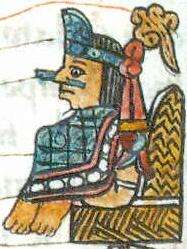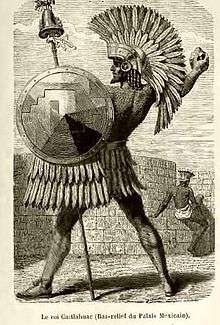Cuitláhuac
Cuitláhuac (Spanish pronunciation: [kwiˈtɬawak] (![]()
![]()
| Cuitláhuac | |
|---|---|
| 10th Tlatoani of Tenochtitlan Ruler of the Aztec Triple Alliance | |
 Cuitláhuac in the Primeros Memoriales. | |
| Reign | 2 Flint 1520 |
| Predecessor | Montezuma II |
| Successor | Cuauhtémoc |
| Successor | Ixhuetzcatocatzin (Alonso) |
| Died | 2 Flint (1520) |
| Wife |
|
| Issue | Ixhuetzcatocatzin (Alonso) Ana Luisa two others |
| Father | Axayacatl |
| Mother | A daughter of Cuitlahuac I |
Biography
Cuitláhuac was the eleventh son of the ruler Axayacatl and a younger brother of Moctezuma II, the late ruler of Tenochtitlan, who died during the Spanish occupation of the city.[4] His mother's father, also called Cuitlahuac, had been ruler of Iztapalapa,[5] and the younger Cuitláhuac also ruled there initially.[6] Cuitláhuac was an experienced warrior and an adviser to Moctezuma, warning him not to allow the Spaniards to enter Tenochtitlan. Hernán Cortés imprisoned both Moctezuma and Cuitláhuac. Following the massacre of Aztec elites when Cortés was away from Tenochtitlan, the Mexica besieged the Spanish and their indigenous allies. Cuitláhuac was released on the pretense to reopen the market to get food to the invaders. Moctezuma was killed under disputed circumstances, and Cuitláhuac was elected tlatoani following the flight of the Spaniards and their allies from Tenochtitlan on June 30, 1520. Some sources claim he was serving in that role even before Moctezuma's death.[7]
Cuitláhuac was ritually married to Moctezuma's eldest daughter, a ten- or eleven-year-old girl, who later was called Isabel Moctezuma.[8]

Cuitláhuac ruled just 80 days, perhaps dying from smallpox[3] that had been introduced to the New World by the Europeans. The early sources do not explicitly say from what he succumbed.[9] Immediately after Cuitláhuac's death, Cuauhtémoc was made the next tlatoani.[3]
Legacy
The modern Mexican municipality of Cuitláhuac, Veracruz and the Mexico City Metro station Metro Cuitláhuac are named in honor of Cuitláhuac. The asteroid 2275 Cuitláhuac is also named after this ruler.
There is an Avenue in Mexico City Called Cuitláhuac (Eje 3 Norte) that runs from Avenue Insurgentes to Avenue Mexico-Tacuba and that is part of an inner ring; also many streets in other towns and villages in Mexico are so called.
See also
Notes
- For year of birth, see entry for "CUITLAHUAC", Dictionnaire de la langue nahuatl classique (Wimmer 2006).
- Wimmer (2006).
- Chimalpahin (1997): pp. 56–57, 164–165, 216–217.
- Chimalpahin (1997): pp. 148–151.
- Chimalpahin (1997): pp. 42–43.
- Chimalpahin (1997): pp. 50–51.
- Burkhart, Louise. "Cuitlahuac" in Encyclopedia of Latin American History and Culture vol. 2, pp. 339-40.
- Chipman, Donald E. (2005). Moctezuma's Children: Aztec Royalty Under Spanish Rule, 1520–1700. Austin: University of Texas Press, pp. 40-41 ISBN 0-292-70628-6. OCLC 5713428
- Burkhart, "Cuitlahuac", p. 340.
References
- Chimalpahin Quauhtlehuanitzin, Domingo de San Antón Muñón (1997) [c.1621]. Codex Chimalpahin, vol. 1: society and politics in Mexico Tenochtitlan, Tlatelolco, Texcoco, Culhuacan, and other Nahua altepetl in central Mexico; the Nahuatl and Spanish annals and accounts collected and recorded by don Domingo de San Antón Muñón Chimalpahin Quauhtlehuanitzin. Civilization of the American Indian series. Arthur J.O. Anderson and Susan Schroeder (eds. and trans.), Susan Schroeder (general ed.), Wayne Ruwet (manuscript ed.). Norman: University of Oklahoma Press. ISBN 978-0-8061-2921-1. OCLC 36017075.
- Wimmer, Alexis (2006). "Dictionnaire de la langue nahuatl classique" (online version, incorporating reproductions from Dictionnaire de la langue nahuatl ou mexicaine [1885], by Rémi Siméon). Retrieved 2010-09-15. (in French and Nahuatl languages)
External links
| Wikimedia Commons has media related to Cuitlahuac. |
| Preceded by ? |
Tlatoani of Itztapalapan | Succeeded by Ixhuetzcatocatzin |
| Preceded by Moctezuma II |
Tlatoani of Tenochtitlan 1520 |
Succeeded by Cuauhtémoc |